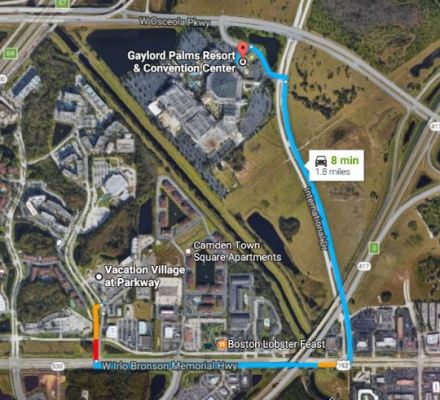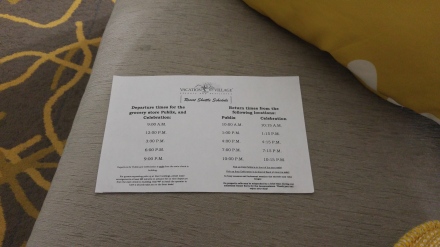I spent last week on vacation in the exurbs of Orlando (well, really Kissimmee) with my partner’s extended family. Since theme parks are, well, really not my thing, I spent a decent amount of time thinking about the planning and urbanist implications of an area that I found frankly fairly miserable from a built environment perspective. I don’t so much have an overarching argument here as a series of notes on a few things I found interesting.
Pod-based building
We were based at a resort called the Vacation Village at Parkway, off the arterial Irlo Bronson Memorial Highway (US 192) west of downtown Kissimmee. In many ways, the sprawling urban form along that road is typical of suburban land use across the country, though perhaps in an exaggerated form. Developments occur in pods, completely disconnected from one another along property lines. Take, for example, this pathetic excuse for a pedestrian crossing from “our” resort to the strip mall and resort next door:

Mind you, one has to traverse this after crossing four lanes and a median of road without a crosswalk of any sort.
The area in which our resort was located is also cut off from its surroundings in a more profound way. It shares a triangle of land with several other developments; the sides of the triangle are defined by I-4 on the west, Bonnet Creek on the east, and 192 on the south. But grid connections–and ways to exit–exist ONLY on the southern side, to 192.

That turns what could be an easy stroll over to the as-the-crow-flies-neighboring Gaylord Palms into a 1.8-mile odyssey along high-speed arterials:

such that Google Maps literally cannot calculate walking directions between the two. This area of Kissimmee is to the south of most of the major Orlando-area attractions, so this kind of thing also lengthens the (many) car trips taken between resorts and said attractions, resulting in even more congestion in an already congested region. It’s just thoughtless–and the result of a zoning regime that emphasizes massive parking lots and setback at the expense of all else, including common sense.
Latent demand for car-free vacations
Despite a built environment that seems to invite, or even mandate, car use at every opportunity, it’s clear to me that there is a latent demand for car-free travel from tourists that could be better met. Transit service in this part of Kissimmee is not completely hopeless, but it’s far from perfect. You can catch a bus to Lynx’s Kissimmee hub four times an hour from the corner of Irlo Bronson and Celebration Boulevard, and they’re even nicely spaced much of the time. The bus stops are nice too:

But service on one of the lines stops by 10 PM.
There’s also a whole network of resort-contracted shuttles that ferry people to and from theme parks, shopping, and entertainment. The vaguely vintage-styled coaches of Disney’s Magical Express, connecting their resorts to the airport, were ubiquitous on the highways, for example. Vacation Village provides shuttles to theme parks, as well as more local destinations.

At the same time, the entire built environment–from single-use zoning to massive setbacks to street and grid geometry–basically mandates car use for the vast majority of trips. I’ve spent more of my life in sprawly suburbia than I really would like, but I got a sense for a latent demand for less autocentricity here more than anywhere else.
Celebration is…Weird
Vacation Village is basically across the street from Disney’s much-debated attempt at New Urbanism. Celebration occupies a bizarre place on all kinds of spectra: more small town than suburb, more private than public, kind of an independent governmental entity but not entirely. I didn’t spend much time there (really just one lunch that was mostly spoiled by rain), but it’s…weird. The built environment blows most of the rest of Central Florida out of the water just by dint of having been thought through even a little bit, but the materials used in the construction of the buildings doesn’t really seem much better than your typical suburb; I saw a lot of sagging gutters and cheap-looking vinyl siding. The main street, such as it is, is touristy but reasonably nice; parking is tucked behind the buildings per standard New Urbanist practice, but it’s still abundant and free. Though not a grid, the street geometry makes more sense than most suburbs. A couple of things jumped out at me, though. This is the main drag carrying cars into Celebration, creatively named Celebration Avenue:

The speed limit drops to 25 mph as soon as you enter the residential part of Celebration–which is nice–but it struck me that despite a nice, wide ROW Celebration Avenue still has very wide travel lanes (much wider than one would expect for a 25 mph speed limit), and no provision for bike lanes.
The other thing that struck me about Celebration? It has zero transit.
Oh, sure, Lynx’s #56 circles through the much more suburb-y single-use commercial section ever half an hour:

From the Lynx system map
But that’s, like, really far from the commercial and residential parts of Celebration:

Celebration is better than other suburbs, sure, but it’s hard for me to accept the word “urbanist” anywhere in proximity to an area that entirely lacks transit service. I suspect the omission is intentional; simply because of the quality of design, Celebration is extremely expensive, and places like that tend not to welcome transit. Do better.
Toll Roads
I don’t want to comment on this too much without reading up more on the background of transportation planning in Central Florida, but the prevalence of toll roads was a common topic of discussion among the extended family. Certainly, it’s annoying that Florida’s extensive toll road network doesn’t accept the EZPass technology common in other parts of the country; outsiders get fleeced by paying higher tolls, in cash. The tolls didn’t seem especially high but the frequency of booths seems potentially counterproductive. I do wonder if a willingness to toll the roads has led to overbuilding of the network, since they may be less of a drag on gas tax revenues and the general fund.
The Great Sucking Sound
We had an enjoyable side trip to Lake Wales, FL, where my grandfather grew up and my great-grandparents and a great-aunt are buried. It’s a very pretty area made famous by the Bok Tower Gardens, but it’s also a struggling agricultural region whose citrus industry–Florida’s Natural is headquartered in Lake Wales–is not exactly at its peak of glory. Consequentially, downtown Lake Wales is struggling to a certain extent. As elsewhere in the country, that struggle is exacerbated by sprawl, particularly the sucking of retail out to low-rent districts on suburban arterials. 6-lane US 27 is the main north-south artery along the Lake Wales Ridge, and it’s characterized by on-and-off clusters of commercial development that become more consistent as one drives north, approaching the Orlando metro. Just outside of Lake Wales, however, the Eagle Ridge Mall stands virtually alone, isolated among cow pastures and citrus groves.

It’s precisely this kind of thing that kills the functional downtowns smaller towns like Lake Wales need to survive in 2016. And the mall’s 20-year history is full of sinkholes and bankruptcies, so it’s not like the competition is going anyone any favors. The mall’s struggles are likely due to its odd, middle-of-nowhere location (I suspect it was placed so as to draw from both Lake Wales and nearby Winter Haven, but it seems to be doing neither). It’s the kind of sloppy economic development and land use policy that has landed so many places like Lake Wales in trouble.
They Paved Paradise and Put Up a Parking Lot
More than anything else, this is the overwhelming experience of Central Florida:

Just out the back door of our building at the resort.
That’s a high-rise looming out of a wetlands, which is cynically preserved to be pretty at right. Just beyond the fence, there’s a short drop to very muddy and wet land; the entire building must be built on a slab of concrete or else it would sink into the muck. It’s hard to go anywhere in the area without thinking of Joni Mitchell’s “Big Yellow Taxi.” Florida’s selling point is, to a large extent, its spectacular natural environment; but its growth as a tourist and retirement destination has been largely premised on the destruction of that environment. I’m hardly the first to point out that paradox, and as someone with training in archaeology, I recognize that destruction is sometimes inevitable. But my overwhelming takeaway from this trip is that there’s a lot of opportunity to just correct things that are sloppy, should political and public will exist. Or, you know, maybe the whole state will just slide into the ocean. That’s always a possibility.
